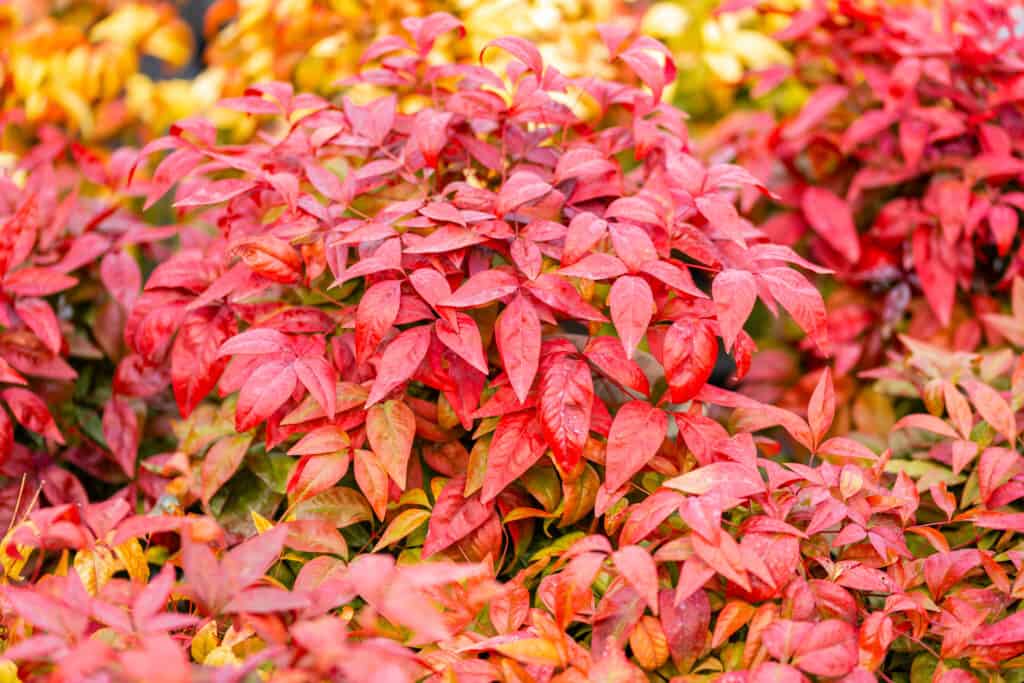Nandina plants are becoming very popular, especially as front yard decorations. This beautiful plant has multiple varieties, which change in color as they mature. Two of the most common and beloved varieties are the blush pink and the firepower nandina. But how can you tell the difference? Or is there a difference at all? Follow along to find out!
Nandina Blush Pink vs. Firepower: Are They the Same Plant?

Technically, nandina is a species usually called the sacred bamboo.
©Joe Kuis/Shutterstock.com
If you think these two plants are similar, there is a reason for this! The blush pink and firepower nandina are closely related. Technically, nandina is a species usually called the sacred bamboo. Within this species are multiple cultivars ranging in color and size. Blush pink and firepower nandina are cultivars. Technically, blush pink is a “new version” of firepower produced to live longer against diseases while maintaining a bold red-pink color during summer and fall.
The History and Origin of Firepower and Blush Pink Nandina
Where do nandina plants come from? These plants are only native to eastern Asia, from the Himalayas to Japan. They are extremely invasive, but a few varieties do not produce flowers or fruit to spread, including firepower and blush pink nandina. They are well-known for their bright red foliage, which sometimes turns pink, green, orange, or green.
All kinds of nandina plants grew in Chinese and Japanese gardens for thousands of years. It was not until 1804 when William Kerr sent it to London, where it was cultivated and bred, ultimately making it in countless gardens across the U.K. and North America. However, they grow poorly in Britain. Instead, they thrive in greenhouses with plenty of humidity and light.
How Big Do Firepower Nandinas Get?

Not all nandina plants grow the same way. There are different cultivars, and some dwarves miss the ability to grow berries.
©Fabrizio Guarisco/Shutterstock.com
So, how big do these plants get? Firstly, we must understand that nandinas are evergreen shrubs. They grow like trees and bushes, with plenty of stalks and luscious foliage. Firepower nandinas reach 2 to 2 and a half feet tall, but this is not why they are impressive. Firepower nandina plants are a bright red during fall and winter. Not all nandina plants grow the same way. There are different cultivars, and some dwarves miss the ability to grow berries.
One of the tallest nandina cultivars is Royal Princess which can easily reach 8 feet tall. It is also a wide plant that requires a lot of space. It is best known for its blush pink foliage and tall height. This is a great plant if you want something for your front yard to pop and also a bushy plant to cover large sections of your yard.
Another unique and beautiful nandina cultivar is the lemon-lime. Instead of the blush pink or fiery red most nandina plants turn, this plant is a bright yellow in spring. The color of the leaves dramatically changes to chartreuse in summer.
Where Is the Best Place to Plant Nandinas?

It is important to understand that not all states in the U.S. allow you to grow nandinas.
©kevpet40/Shutterstock.com
Nandinas grow best in USDA zones 6 to 11. They are easy to care for, but hard to get rid of and spread quickly. Before you can start growing these beautiful plants, it is important to understand that not all states in the U.S. allow you to grow nandinas. Florida, for instance, recommends growing sterile varieties so they don’t accidentally spread. Firstly, nandina plants are super invasive and spread quickly. They spread through the wind as it carries the seeds and because of birds. Also, nandina berries are super toxic to birds and other small animals. Don’t let the red pretty-looking berries fool you, they contain high amounts of cyanide.
Tips and Tricks on Growing Nandina Pink vs. Firepower
You are in luck. Regardless of which nandina cultivar you choose to grow, they are all low-maintenance plants. Instead, to save the small birds as well as your surrounding ecosystem, we recommend purchasing a sterile non-seed producing plant. You can use any type of soil, including clay and sand, but these plants typically thrive in moist and nutrient-high soil. Nandina blush pink and firepower requires full sun for at least six hours. However, during hot summer days, especially in states with strong sunlight like Florida, the sun can so intense it can burn the leaves.
Another trick to growing nandina plants is to add mulch at the base of the plant. The mulch not only helps fight off
fungus but is also perfect for lowering the chance of frost. These cold-tolerant plants can withstand temperatures lower than zero degrees Fahrenheit but will stop growing until they receive another warmth and sunlight during spring and summer. Unless you are purchasing a dwarf nandina plant, you will need to prune back the plant at least twice a year. If not, the foliage can get out of control as it grows like a bushy tree.
Up Next:
5 Best Annual Flowers For Zone 6
Hellebore vs Lenten Rose: What Are Their Differences?
Gardenia vs Camellia: 5 Key Differences
The photo featured at the top of this post is ©
Sources
- University of Florida Gardening Solutions, Available here: https://gardeningsolutions.ifas.ufl.edu/care/weeds-and-invasive-plants/nandina.html
Thank you for reading! Have some feedback for us? Contact the AZ Animals editorial team.






